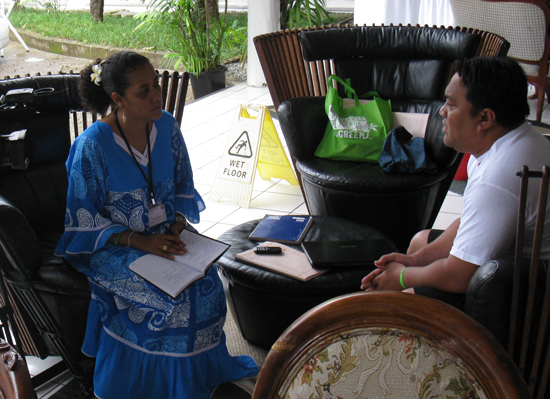
OPINION: The South Pacific media has been wracked by deep division over how journalists should respond to the 2006 Fiji coup and Frank Bainimarama’s continuing hold on power. The last gathering in Vanuatu three years ago of members of PINA – the Pacific Islands News Association – was marred by bitter infighting, so much so that a group of mainly Polynesian delegates broke away and set up a rival organisation, the Pacific Islands Media Association ( PasiMA).
There were unprecedented scenes of acrimony at the conference venue in Port Vila. One prominent delegate threatened to kill another. And the then editor of The Fiji Times, Netani Rika, stormed out in protest at the presence of two representatives of Fiji’s Information Ministry, one of whom was reduced to tears by the vitriol aimed in her direction.
It clearly wasn’t the most pacific of occasions. And many delegates expected more of the same at the 2012 PINA summit in Fiji – the cause of all the trouble in the first place.
Yet three years on, the hand of sweet reason appears to have descended on the region’s media professionals, judging from events at Pacific Harbour, the rain-drenched summit venue.
The deeply religious head of the PINA secretariat, Fiji’s Matai Akauola, cast it as the hand of God bringing peace to his fractured media flock. Either way, the 2012 PINA summit was notable for healing some of the deep divisions of the past.
By week’s end, mutterings of a further bitter showdown had evaporated and in their closing comments, delegates preached reconciliation and unity. Instead of the feared disaster, the summit proved to be a triumph for the quietly spoken PINA president, Vanuatu’s Moses Stevens, who was re-elected for another term.
Chief among the peacemakers was the deputy chair of the breakaway PasiMA group –the influential Tongan publisher, Kalafi Moala – who ignored a last minute call for a boycott from some of his Polynesian colleagues. There were still some notable absentees, including anyone from Radio NZ International. Yet the final turnout of around 180 media professionals and NGO observers clearly re-establishes PINA’s mana as the pre-eminent voice of Pacific journalism.
Split over Fiji
In their response to events in Fiji, Pacific journalists have been split along the same lines as their governments. On the one side are the Melanesians – Papua New Guinea, Solomon Islands and Vanuatu – who are largely sympathetic. And on the other, the Polynesians – Tonga, Samoa, the Cook Islands and Niue – who take a more insistent line on democracy and media freedom in common with their Australian and NZ colleagues.
There was certainly a palpable thawing of attitudes over the week, according to Professor David Robie, the director of the influential Pacific Media Centre at Auckland’s University of Technology. He described the summit as a “turning point” in bringing the Melanesians and Polynesians together again and asserting the celebrated “Pacific Way” of resolving differences. For his part, Matai Akaoula said he’d “prayed long and hard for a PINA miracle” and was grateful that those prayers had been answered.
So what changed aside from the warm Fijian hospitality, which appeared to mollify even the most diehard of its traditional critics? Undoubtedly, there was a dawning recognition of the realpolitik on the ground in Fiji, which many delegates were exposed to for the first time. More than five years after his coup, Voreqe Bainimarama remains in power and clearly has the acceptance, if not the support, of many of his countrymen. He’s also been embraced by his fellow Melanesian leaders, appears to run a competent government, says he’s committed to a multiracial future and seems intent on keeping his promise to return Fiji to a purer form of democracy before September, 2014.
None of this was evident at the time of the PINA ructions three years ago.
In a clear sign of how sentiment has shifted, the 2012 summit was opened by none other than the Fijian leader himself. However uncomfortable it may have been for some of those present, Bainimarama’s speech was heard in respectful silence and he even drew applause when he said that too many Pacific journalists were “used and abused” and deserved better pay.
While the Radio Australia reporter Bruce Hill publicly complained that there was no opportunity afforded for the journalists present to question Bainimarama, even private criticism of the Fijian leader among the delegates was muted. Kalafi Moala – an eminence grise of Pacific journalism – pronounced himself “genuinely impressed” with the Fijian leader. He said it was clear that Fiji was being “well governed” and there had been “a noticeable improvement in race relations” since he’d last visited the country.
A principal thorn of contention has been removed – the strict media censorship that Bainimarama imposed in the wake of his coup. Now that military censors have been withdrawn from the country’s newsrooms, the Fiji media has been taking the first tentative steps towards regaining its once vigorous voice.
Regime critics
Media outlets have begun reporting comments by regime critics whose own voices have long been suppressed, including former prime ministers Laisenia Qarase and Mahendra Chaudhry. Yet many local journalists remain fearful of retribution under the punitive decrees that have replaced the censor’s red pen.
While Fiji’s leaders can say what they like about their opponents under new defamation laws, the same does not apply in reverse.
It was noticeable that Fijian panelists at PINA such as Fred Wesley, the current editor of the Fiji Times, were apt to choose their words carefully when it came to commenting on their relations with the regime. Small wonder when the government has already filed six formal complaints about the Fiji Times to the country’s new Media Authority since censorship was lifted in January. These assert that in successive stories, the FT failed to display balance by not seeking an official response to articles critical of the government. It’s seemingly not enough to reflect balance within the same news cycle. The regime wants it in the same story on the same day.
The same trepidation has accompanied Bainimarama’s insistence – restated in his PINA speech – that while the local media “does not have to be pro-government, it must be pro-Fiji”. He told the gathering that he’d been given the phrase by Singapore’s Prime Minister, Lee Hsien Loong, and “completely agreed” with the sentiment. The media’s job, he said, was to “inform the citizenry, inspire constructive public debate and help fight corruption”.
But what does it really mean to be “pro-Fiji” in Bainimarama’s dictatorship”? “L’etat c’est moi” – the state is me – France’s Sun King, Louis XIV, famously declared. Does the same apply in Fiji? Does it preclude criticism of Bainimarama himself?
In the uncertain aftermath of the formal lifting of censorship, the average working journalist is still walking on eggshells, acutely conscious that it hasn’t taken much to be branded “anti-Fiji” in the past. Has overt censorship in Fiji merely been replaced by an insidious form of self-censorship? While none of this was canvassed formally in the PINA sessions, it was certainly the subject of much conjecture behind the scenes.
The sole public slanging match came courtesy of Radio Australia when – in an interview with Bruce Hill for Pacific Beat – a Papua New Guinea government official, Paulius Korini, maintained that it wasn’t the job of journalists to challenge governments. An enraged Kalafi Moala – who was once jailed by the Tongan government for precisely such a challenge –appeared on a subsequent Pacific Beat segment branding his fellow islander “arrogant and ignorant”, stridently asserting that challenging governments was, in fact, one of the media’s key roles.
'Vicar's tea party'
Yet aside from this flare-up, controversy at PINA was noticeably absent, so much so that Bruce Hill complained to participants in another RA panel discussion that “it was like attending a vicar’s tea party”.
The Pacific Media Centre’s David Robie observed that without Hill’s presence, there would have been little dissention at PINA. Robie described the PNG-Moala fracas as a construct of “Western-style conflict journalism”. Hill, he said, had set out to generate controversy by seeking a contentious opinion and then using it to generate more controversy. This, of course, is routine journalistic practice in Australia and NZ.
But it goes to the heart of the continuing debate about whether the form of journalism practised in the advanced democracies is appropriate for developing countries such as those in the Pacific, where the words “constructive” and “positive” are routinely a prerequisite for any criticism of government.
One negative Pacific journalists appear to share with their Western counterparts is diminishing trust and respect in the eyes of media consumers. It was my task to address this issue at PINA’s opening session. And while I was able to point to clear research that most Westerners no longer trust their media, no such research exists in the Pacific.
So I asked for a show of hands on the question: “Who in the room comes from a country where journalists are admired, trusted and respected, where if you were to say ‘trust me I’m a journalist’, people wouldn’t crack up laughing?”
It’s instructive that none of the delegates from the Pacific’s bigger players – Papua New Guinea, Fiji, Tonga, the Solomons and Vanuatu – raised their hands. The Samoan prime minister’s loquacious media advisor raised his, as did some of the smallest players – from the Cook Islands, tiny Niue and a Kanak radio journalist from New Caledonia.
In population terms, these are minnows. So on arguably the most important issue of all for journalists the world over – the loss of credibility with their readers, viewers and listeners – Pacific journalists are clearly no different from anyone else.
This work is licensed under a Creative Commons Attribution-NonCommercial 3.0 New Zealand Licence.




